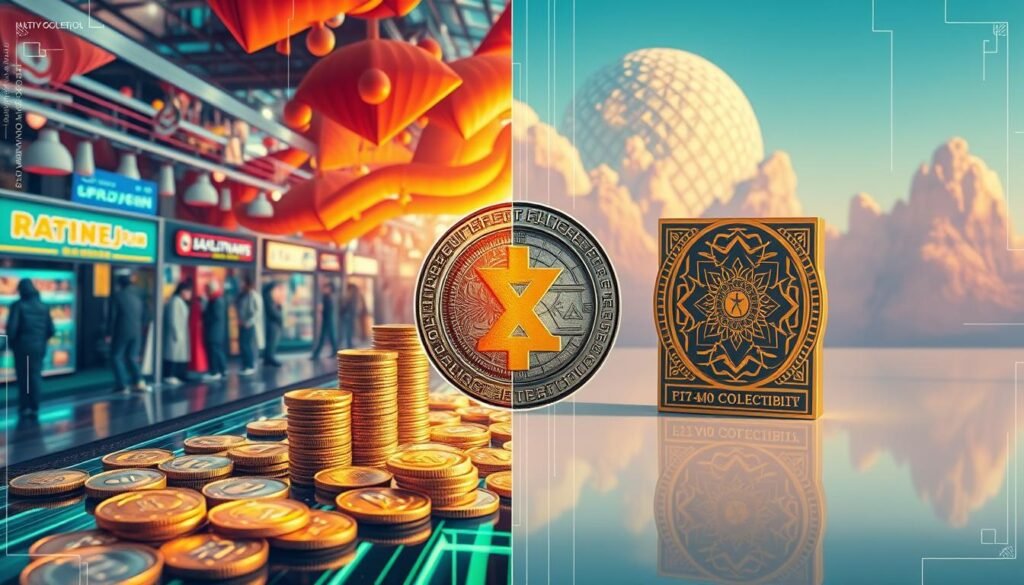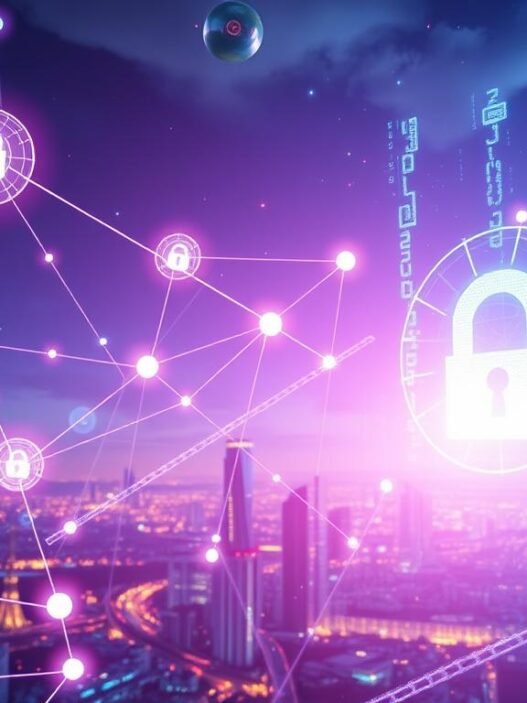Have you ever wondered why a digital artwork sold for $69 million? Non-Fungible Tokens (NFTs) are changing how we see digital ownership and value. They use blockchain technology to make digital items unique, allowing creators to buy, sell, and trade them. This has led to huge trading volumes and market growth.
In Q3 2021, the trading volume for NFTs hit $10.67 billion, a 700% jump from the previous quarter1. Our NFT guide will show you how NFTs work, their special features, and the difference between them and other tokens.
On this journey, you’ll see how NFTs are used in digital art and gaming. You’ll also learn about famous NFT projects like CryptoPunks and the Bored Ape Yacht Club. These projects have attracted celebrities and collectors.
As we explore NFTs, you’ll understand their impact on digital ownership and the economy. You’ll see both their benefits and drawbacks. This will help you grasp this new and exciting digital world.
Key Takeaways
- NFTs create unique digital ownership verified through blockchain technology.
- The market for NFTs experienced rapid growth, reaching $10.67 billion in Q3 2021.
- Notable NFT projects include CryptoPunks and Bored Ape Yacht Club.
- Digital artists have gained unprecedented value for their work through sales of NFTs.
- NFTs present both opportunities and challenges in the digital economy.
What are Non-Fungible Tokens (NFTs)?
Non-fungible tokens (NFTs) are unique digital assets that show you own something special. They are recorded on a blockchain. Unlike regular tokens, NFTs can’t be swapped for another one because they are one-of-a-kind. They can be linked to digital or physical items like art, music, and collectibles, proving you own them.
The art world has seen a big jump in NFTs. For example, Grimes made $6 million from selling NFTs, with one video selling for $388,938. Beeple’s “Everydays: The First 5000 Days” sold for over $69 million2. Also, OpenSea’s market cap hit $1.4 billion during this time3.
NFTs have brought new ways to make money in art, entertainment, and gaming. They let creators sell their work directly, changing how we value and buy art. Trading went from $82 million in 2020 to $17 billion by 20213. But, in 2022, the market dropped by over 90% from the year before3.
NFTs are changing how we think about digital ownership. They mix technology with creativity. Programs like the SMU M.A. in Creative Technology show how important they are4.
How do NFTs Work?
NFTs use blockchain technology, a secure digital ledger. Each NFT has unique codes stored on the blockchain. This ensures ownership and authenticity5. CryptoKitties, launched in 2017, was the first to show NFTs’ transferability and proof of ownership6.
Smart Contracts are key in creating and managing NFTs. These contracts automate transactions and can include royalty payments for creators5. NFTs can be anything from digital art to event tickets5. They are used in many ways, like for fan engagement and in-game items5.
The ERC-721 and ERC-1155 standards help create NFTs on Ethereum. In 2021, Beeple’s art collection sold for over $69 million, showing NFTs’ growing popularity6.

However, NFTs face challenges like tech complexities and legal issues. There’s also the environmental impact of blockchain networks5. To solve these, we’re looking at energy-saving tech and Layer 2 solutions like Polygon5.
The Unique Features of NFTs
NFTs have special qualities that make them valuable in the digital world. One key feature is NFT Uniqueness. Each token has its own unique code, proving they are all different7. This makes them very sought after, especially in digital art and music.
Another important feature is Indivisibility. NFTs can’t be split into smaller parts. Unlike some cryptocurrencies, NFTs are whole entities8. This ensures they are solid proof of digital ownership, covering art, collectibles, and even real estate.
Digital Ownership adds to NFTs’ appeal. It lets people prove they own unique items on the blockchain. This ownership is clear and can’t be changed7. Sites like OpenSea and NBA Top Shot use this tech for safe trading.
Scarcity is what makes NFTs so popular. They are made in limited numbers, which increases their value. This has made them attractive to collectors and investors, but it also brings risks8.
NFTs can be many things, like photos, videos, and music files8. They act as digital proof of ownership. This makes them useful for more than just art, like in gaming, virtual real estate, and digital identity7.
| Feature | Description |
|---|---|
| NFT Uniqueness | Each NFT has a unique identification code, verifying its individuality. |
| Indivisibility | NFTs cannot be divided; they exist entirely as whole tokens. |
| Digital Ownership | Establishes verified ownership of unique digital assets on a blockchain. |
| Scarcity | Limited supply heightens the desirability and value of NFTs. |
Key Differences Between Fungible and Non-Fungible Tokens
Understanding fungibility is key when looking at NFT vs. Cryptocurrency. Fungible tokens, like Bitcoin and Ethereum, can be swapped for each other. They have the same value and can be exchanged easily. This makes them good as money and investments in the digital world9.
On the other hand, non-fungible tokens (NFTs) are special and can’t be swapped one for one. They are unique digital items like art, music, or virtual land10. This makes them stand out as individual items, not just money or investments.
NFTs use standards like ERC721 on the Ethereum network. This ensures they are rare and their ownership is real9. While fungible tokens are mainly for trading, NFTs are used for collecting, gaming, and more. This shows they have a wider role in the digital world10.
In a Token Comparison, we see their different uses. Here’s a quick look at what makes them different:
| Feature | Fungible Tokens | Non-Fungible Tokens |
|---|---|---|
| Interchangeability | High | Low |
| Value Basis | Inherent | Derived from the asset |
| Usage | Currency, trading | Art, collectibles, virtual real estate |
| Standards Used | ERC20 | ERC721 |
| Marketplace Examples | Coinbase, Binance | OpenSea, Rarible |
In summary, fungible and non-fungible tokens play different roles in the digital world. The main difference is in how they can be swapped and their value. This affects how we use them in the digital landscape11.

Popular Use Cases of NFTs
NFT Applications are growing fast, showing new uses in many fields. In art, artists turn their work into Digital Collectibles. This lets collectors buy unique pieces directly. For example, Beeple’s “Everydays: The First 5000 Days” sold for about $69.4 million at Christie’s, showing NFTs’ growing value12.
Also, series like CryptoPunks and Bored Ape Yacht Club show how NFT art can attract lots of attention and money13.
In gaming, NFTs act as Virtual Assets. Games like Axie Infinity let players earn crypto by trading these assets. This offers real economic chances. Games like CryptoKitties, where you trade virtual cats, are also very popular13.
Music artists like John Legend and Kings of Leon use Music NFTs to make money and give fans special perks. Kings of Leon even released a song into space, showing their creativity14.
Virtual Real Estate is also growing, with big names and celebrities buying digital land in the metaverse. Brands like iHeartMedia and Gucci, and stars like Paris Hilton, see the value in virtual property12.
NFTs are also entering new areas like food and entertainment. For example, McDonald’s is selling recipes as NFTs. In entertainment, NFTs are making ticketing safer and more transparent, reducing fraud1413.
| Industry | Use Case | Key Examples |
|---|---|---|
| Art | Tokenized artwork sales | Beeple, CryptoPunks |
| Gaming | In-game asset trading | Axie Infinity, CryptoKitties |
| Music | Tokenizing songs and experiences | Kings of Leon, Grimes |
| Entertainment | Secure event ticketing | NFT ticket sales |
| Virtual Real Estate | Buying and selling digital land | Decentraland, The Sandbox |
| Food & Beverage | Tokenized recipes | McDonald’s, Wendy’s |
NFTs are changing how industries work, offering new ways to connect with customers and make money.
How to Buy Non-Fungible Tokens (NFT)
Buying NFTs is an exciting journey into digital assets. First, you need to pick a good NFT marketplace. There are many platforms, each with its own features and fees. It’s important to do your research before starting.
Choosing an NFT Marketplace
Many NFT marketplaces are popular. OpenSea is the biggest, supporting over 150 payment tokens. Other big names include Rarible, Magic Eden, and NBA Top Shot, each with their own special features and fees.
For example, OpenSea takes a 2.5% fee on secondary sales and fees from 2.5% to 10% on new mints15. Magic Eden has no listing fee but charges different transaction fees15. Rarible’s fees go from 0.5% to 7.5% based on the transaction price15.
Setting Up a Digital Wallet
Setting up a digital wallet is key for managing NFTs. MetaMask and Coinbase Wallet are top picks for secure crypto asset storage16. Your wallet keeps your NFTs safe and makes buying easy across different platforms.
Steps to Purchase an NFT
Buying an NFT is simple. First, log into your chosen marketplace. Then, look through the many listings. Choose your NFT and pay with your digital wallet.
Remember, gas fees can be high during busy times, affecting the NFT’s price15. Also, watch out for extra fees like ACH withdrawal fees and transaction costs15.
Prominent NFT Projects and Trends
In the world of NFTs, CryptoPunks and Bored Ape Yacht Club have made a big impact. CryptoPunks is known for its pixel art characters, marking the start of the NFT movement. These unique pieces became very popular, leading to millions of dollars in sales17.
Bored Ape Yacht Club focuses on building a community. It offers special perks to its members. This shows how NFTs can bring people together, with avatars becoming symbols of status and belonging18.
New trends in NFTs include turning real-world assets into digital tokens, a $16 trillion market by 2030. Axie Infinity has made over $4 billion, showing NFT gaming’s appeal17. Also, fractional NFTs let people own parts of valuable NFTs, opening up more investment chances.
The NFT market is set to hit $152.54 billion by 2030. Projects like CryptoPunks and Bored Ape Yacht Club are key in shaping this future. They show how digital art ownership is evolving and its impact on the market.
Benefits and Criticisms of NFTs
NFTs offer big advantages for creators, opening up new ways to earn money and control their work. Artists can earn from their work even after it’s sold, thanks to NFTs. This helps them keep their rights in the digital world. Also, NFTs make it easier for people to join a global market, where many items are sold daily for fun19.
However, NFTs also have their downsides. One big issue is how much energy they use, which is bad for the environment. They also don’t have strong rules to protect buyers, which can lead to scams1920. People investing in NFTs should be careful because the market can be very unpredictable20.
In conclusion, NFTs are changing how we own things online and opening up new business ideas. But, we need to be careful and understand the risks. Talking about how to make NFTs better for the planet and setting up better rules for them is important for their future21.















